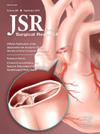评估甲状腺结节的胰高血糖素样肽-1类似物使用者患甲状腺癌的风险
IF 1.7
3区 医学
Q2 SURGERY
引用次数: 0
摘要
甲状腺结节是常见的,由于其潜在的恶性肿瘤,需要警惕监测。它们在使用胰高血糖素样肽(GLP-1)类似物的患者中变得特别令人担忧,这与甲状腺髓样癌的风险增加有关。本研究旨在评估GLP-1类似物治疗甲状腺结节患者甲状腺癌的发生率。方法:采用TriNetX数据库对1995年至2024年间诊断为甲状腺结节(ICD-10-CM E04)并接受GLP-1类似物(ATC A10BJ)治疗的儿童和成人患者进行回顾性队列研究。此外,我们比较了GLP-1组与开始使用二甲双胍后出现甲状腺结节的患者组。评估人口统计学数据和生化指标。主要终点是甲状腺癌的发生率,通过诊断甲状腺结节和开始GLP-1类似物后首次出现ICD-10-CM C73来确定。描述性统计总结了基线特征,Kaplan-Meier生存分析估计了甲状腺癌的累积发病率。使用TriNetX Analytics平台进行分析,统计显著性定义为P <;0.05.结果在我们的数据库中,我们确定了1,401,568例使用GLP-1类似物的患者和2,779,340例甲状腺结节患者。其中,171460例患者同时患有这两种疾病,其中98142例(57%)在开始GLP-1类似物治疗后出现甲状腺结节。GLP-1队列的平均年龄为60±13岁,其中72% (n = 66195)为女性,66% (n = 60855)为白人。Kaplan-Meier分析显示,GLP-1队列的生存概率(即研究结束时不发生甲状腺癌的可能性)为91.042%,共观察到4687例甲状腺癌。相比之下,二甲双胍组(n = 306,114)的生存率更高,为94%,观察到11,898例甲状腺癌。队列间的风险比为0.99(95%可信区间:0.96-1.03),表明使用GLP-1类似物的患者与使用二甲双胍的患者发生甲状腺癌的风险无显著差异。结论sour研究表明,GLP-1类似物治疗甲状腺结节患者的甲状腺癌发病率相对较低。本文章由计算机程序翻译,如有差异,请以英文原文为准。
Evaluating Thyroid Cancer Risk in Glucagon-like Peptide-1 Analog Users With Thyroid Nodules
Introduction
Thyroid nodules are common and require vigilant monitoring due to malignancy potential. They become particularly concerning in patients using glucagon-like peptide (GLP-1) analogs, which are associated with a proposed increased risk of medullary thyroid cancer. This study aims to evaluate the incidence of thyroid cancer in patients with thyroid nodules treated with GLP-1 analogues.
Methods
We conducted a retrospective cohort study using the TriNetX database looking at pediatric and adult patients diagnosed with thyroid nodules (ICD-10-CM E04) and treated with GLP-1 analogues (ATC A10BJ) from 1995 to 2024. In addition, we compared the GLP-1 cohort to a cohort of patients who developed thyroid nodules after starting metformin. Demographic data and biochemical markers were assessed. The primary outcome was the incidence of thyroid cancer, identified by the first occurrence of ICD-10-CM C73 following the diagnosis of thyroid nodules and the start of GLP-1 analogues. Descriptive statistics summarized baseline characteristics, and Kaplan–Meier survival analysis estimated the cumulative incidence of thyroid cancer. Analyses were performed using the TriNetX Analytics platform, with statistical significance defined as P < 0.05.
Results
We identified 1,401,568 patients using GLP-1 analogues and 2,779,340 patients with thyroid nodules in our database. Among these, 171,460 patients had both conditions, with 98,142 (57%) developing thyroid nodules after starting GLP-1 analogues. The average age of the GLP-1 cohort was 60 ± 13 years, with 72% (n = 66,195) being female and 66% (n = 60,855) identifying as White. Kaplan–Meier analysis indicated that the survival probability, or the likelihood of not developing thyroid cancer by the end of the study, was 91.042% for the GLP-1 cohort, with 4687 cases of thyroid cancer observed. In comparison, the metformin cohort (n = 306,114) had a higher survival probability of 94%, with 11,898 cases of thyroid cancer observed. The risk ratio of 0.99 (95% confidence interval: 0.96-1.03) between the cohorts indicates no significant difference in the risk of developing thyroid cancer for patients on GLP-1 analogues compared to those on metformin.
Conclusions
Our study indicates a relatively low incidence of thyroid cancer among patients with thyroid nodules treated with GLP-1 analogues.
求助全文
通过发布文献求助,成功后即可免费获取论文全文。
去求助
来源期刊
CiteScore
3.90
自引率
4.50%
发文量
627
审稿时长
138 days
期刊介绍:
The Journal of Surgical Research: Clinical and Laboratory Investigation publishes original articles concerned with clinical and laboratory investigations relevant to surgical practice and teaching. The journal emphasizes reports of clinical investigations or fundamental research bearing directly on surgical management that will be of general interest to a broad range of surgeons and surgical researchers. The articles presented need not have been the products of surgeons or of surgical laboratories.
The Journal of Surgical Research also features review articles and special articles relating to educational, research, or social issues of interest to the academic surgical community.

 求助内容:
求助内容: 应助结果提醒方式:
应助结果提醒方式:


